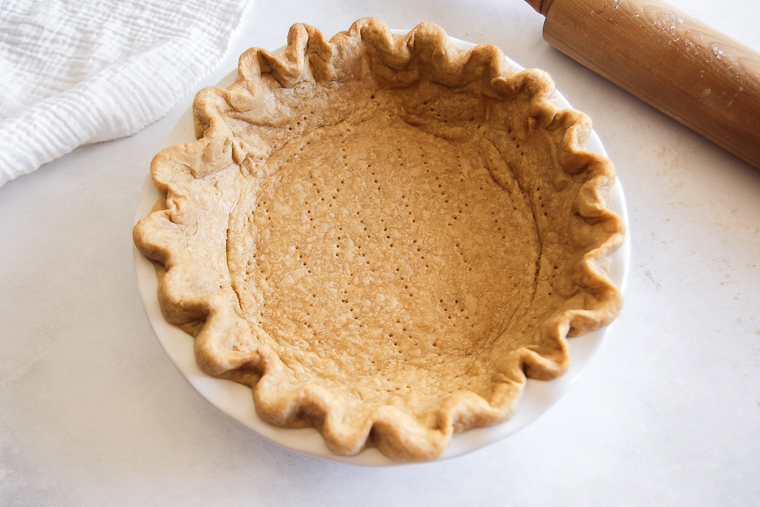
This post may contain affiliate links. See my full disclosure. As an Amazon Associate, I earn from qualifying purchases.
This flaky all-butter pie crust is made with 100% whole wheat pastry flour or freshly milled soft white wheat! Keep this recipe on hand to use for pie, quiche, galette, homemade toaster pastries, and more!

Since we mill our own flour and make many of our baked goods with whole grains, I wanted to start baking a healthier whole wheat pie dough too.
In my opinion, pie pastry should be just as tasty as the filling.
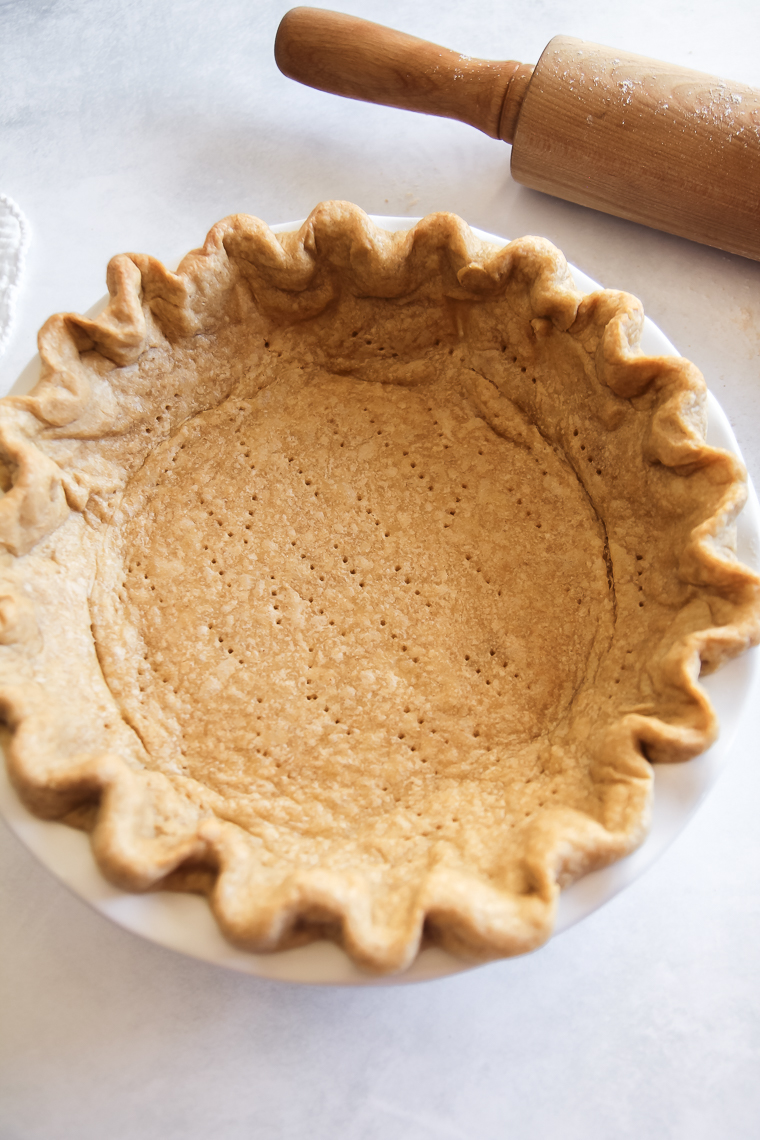
I’m a huge fan of a light and flaky all-butter crust, so it’s important to me that a crust made with 100% whole wheat flour would have similar appeal.
In the past I would prepare my pie pastry in the food processor to save time. But pulverized butter just doesn’t form substantial air pockets and layers in the pie pastry the way bigger pieces can in a handmade crust.
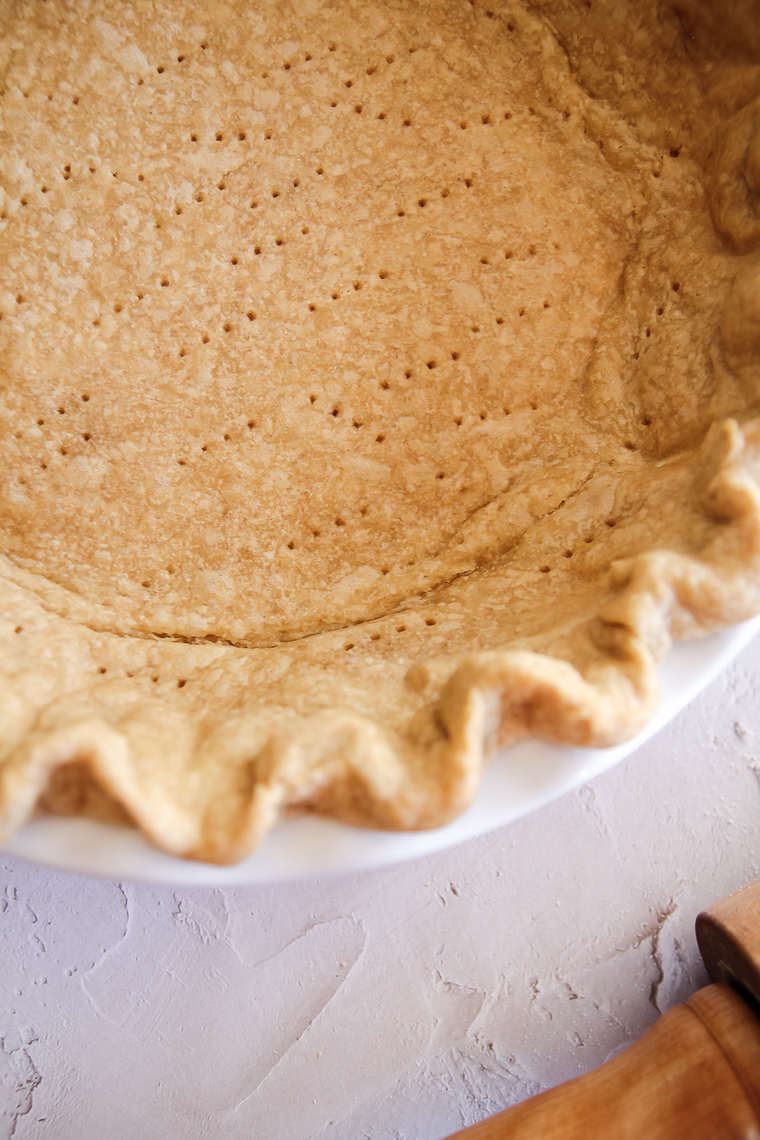
Thankfully, it really doesn’t take too much more effort to make the crust by hand. I’ll show you exactly how to do it for a great outcome!
Pie crust is one of those doughs that can be made in advance and frozen! This is especially helpful around the holidays.
This recipe yields enough for one pie with a double crust or two pies with single bottom crusts.
Whole Wheat Pie Crust Flour Notes
If you’re picking up flour from the store, choose a whole wheat pastry flour for this recipe. Regular whole wheat flour has a higher protein percentage. It would make a drier crust with a different outcome texture-wise.
Pie Crust With Freshly Milled Flour
I’m partial to grinding my own organic whole grains using a countertop stone mill. I bake primarily with the flour I make myself.
I want our baked goods to have added nutrition and fiber, and there’s something truly special about the flavor and aroma of fresh flour. I have an entire post devoted to this topic here.

If you’re milling your own, choose a soft white or red wheat. Soft wheats have a lower protein content for a more tender pie pastry. You can weigh your wheat berries prior to milling for ease.
Spelt would work wonderfully too.
Tips for Making This Whole Wheat Pie Crust Recipe
- This recipe is listed in grams for accurate results, so you’ll need a digital kitchen scale.
- Keep the ingredients as cold as possible! Freshly milled flour is warm, so the flour should be chilled or left to cool to room temperature prior to making the dough. Cube cold butter straight from the refrigerator, and use ice cold water.
- You may need to make small adjustments to the amount of water because of differences in grains/flours. A properly hydrated pie dough shouldn’t crack while forming into a disc or rolling out. An over-hydrated dough will be overly sticky to work with and will almost “smear” on the counter while rolling.
- Chilling the dough gives the bran in the whole grain flour the time it needs to fully absorb the water. This is important to prevent the crust from cracking during baking.
- I show you how to fold the dough over itself to create some layering in the pie crust. However, don’t overwork the dough more than necessary for the most tender crust.
How to Make Whole Wheat Pie Crust (Step-by-Step Instructions)
Step 1 – Whisk Dry Ingredients
First, add your whole wheat flour into a bowl with the granulated sugar and kosher salt. Feel free to increase the amount of sugar called for to 1 tablespoon if you prefer a sweeter crust, or you can omit it altogether.
Whisk the dry ingredients to combine.
Step 2 – Cut in Cold Butter Cubes and Add Liquid
Add cold butter cubes into the bowl and begin working the butter in using a pastry cutter.
When you’re finished, there shouldn’t be too much loose flour at the bottom of the bowl. The butter should still be in substantial pieces… some “pea” sized, and some a little larger.

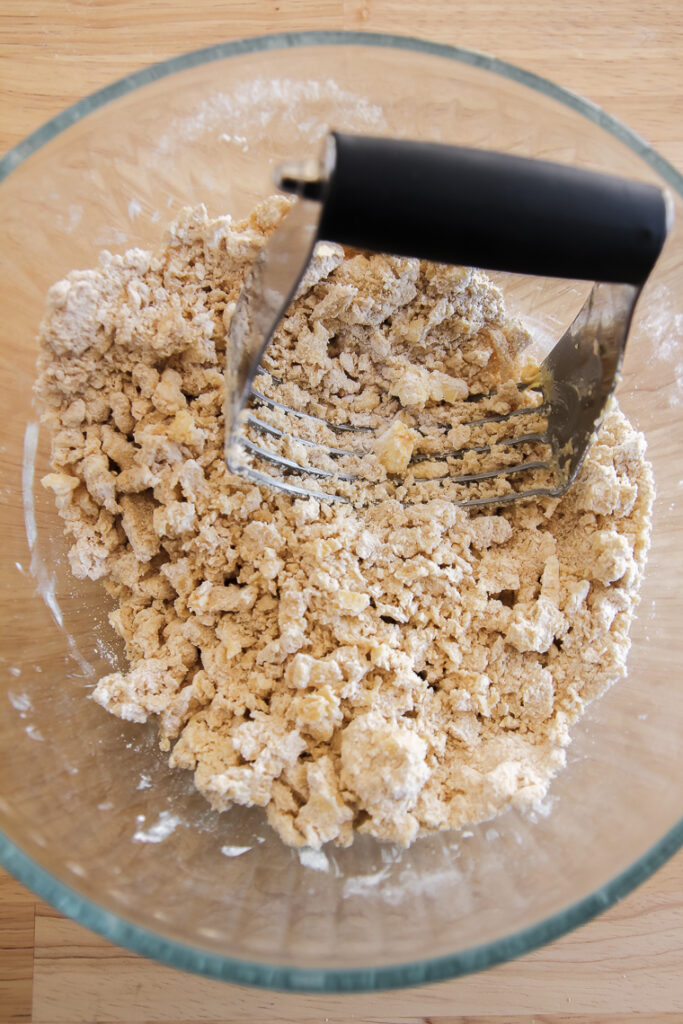
Two alternate methods if you don’t own a pasty cutter:
1. Grate cold butter using a box grater, then chill. Toss the cold grated butter into the dry mixture to incorporate and proceed with step 3.
2. Pinch in butter cubes by hand between your thumbs and fingers.
Mix vinegar into the water (vinegar also inhibits gluten development for a tender crust), then drizzle the water into the butter/flour mixture.
Use a fork or dough whisk to incorporate the water. The whole wheat pie crust dough will still look quite shaggy.

Step 4 – Fold in the Bowl and Chill
At this point, use your hand to fold the dough over itself 4-5 times. This will create layers in the pie dough.
Add more water a sprinkle at a time if you feel like the dough is still dry.


Slice the finished dough in half, place each half on a piece of plastic wrap, and wrap as you form each half into round a disc.
Chill for 2 hours or overnight.
Step 5 – Roll and Shape Whole Wheat Pie Crust
After chilling, you may use your whole wheat pie pastry according to whatever recipe you are using.
You’ll need to flour your surface before rolling, and use short outward strokes, rotating the dough after each roll to achieve a round shape.




If the dough no longer feels chilled after rolling and shaping, cover and chill for another 10-15 minutes before baking.
Insure you line the crust with parchment paper and fill the crust with pie weights if par- or blind-baking the crust.

Make Ahead Options
You may refrigerate the dough overnight and make your pies the next day. For longer storage, I would recommend freezing your pie dough to prevent the dough from oxidizing (turn a gray tinge) in the refrigerator.
And as I mentioned previously, freezing the dough ahead of time is a life saver if you’re bringing pies for a party or get-together!
Simply place the pie dough in the refrigerator to thaw slowly the day before you want to bake your pies.
I’m so grateful for your comments, reviews, and questions! Your star ratings help others discover my recipes, and your feedback helps me make improvements. Thank you for your support!
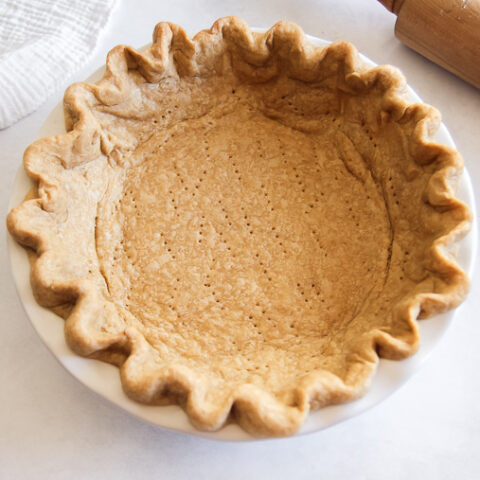
Whole Wheat Pie Crust
This flaky all-butter pie crust is made with 100% whole wheat pastry flour or freshly milled soft white wheat! Keep this recipe on hand to use for pie, quiche, galette, homemade toaster pastries, and more!
Ingredients
- 315g whole wheat pastry flour (see notes)
- 1 tsp granulated sugar (or up to 1 Tablespoon if you prefer a sweeter crust, or omit)
- ½ tsp kosher salt
- 227g (1 cup) salted butter, cold and cut into cubes
- 170g water, ice cold (plus more if needed)
- ½ tsp lemon juice or unfiltered apple cider vinegar
Instructions
- Mix: Whisk together flour, sugar, and salt in a medium-sized bowl. Cut butter cubes into dry mixture using a pastry cutter until loose flour is mostly worked in and pea-sized and larger chunks of butter remain. (You can also grate the butter with a box cutter and chill ahead of time or pinch it in with your thumbs and fingers if you don't have a pastry cutter.)
- Stir vinegar or lemon juice into cold water, then drizzle water into flour and butter mixture. Stir with a fork or dough whisk until mixture begins to come together (if your dough feels extra dry, add more water a sprinkle at a time).
- Folds: Use your hand in the bowl to fold the dough over itself 4-5 times until no dry flour remains (this step also serves to add layers into the dough). Don't overwork the dough.
- Chill: Divide dough into two equal portions (form into discs as you wrap in plastic wrap). Chill for two hours or overnight. For longer storage, place wrapped discs in a freezer bag and freeze for up to three months. Refrigerate overnight to thaw before using.
Notes
- Flour notes: Use a whole wheat pastry flour instead of regular whole wheat flour. If you're milling your own, mill soft red or soft white wheat. Let flour cool to room temperature (or chill) after milling. Small adjustments to the amount of water may be necessary due to differences in flours.
- Keep the ingredients and dough cold for the best results.
- Dough hydration notes: Dough should be hydrated enough that it won't crack while forming into a disc or rolling out, but not so wet that it feels overly sticky like it would smear on the countertop when rolled.
Recommended Products
As an Amazon Associate and member of other affiliate programs, I earn from qualifying purchases.
Nutrition Information:
Yield: 8 Serving Size: 1Amount Per Serving: Calories: 239Total Fat: 4gSaturated Fat: 2gTrans Fat: 0gUnsaturated Fat: 2gCholesterol: 9mgSodium: 128mgCarbohydrates: 43gFiber: 5gSugar: 2gProtein: 8g
*Nutrition information is not always accurate.

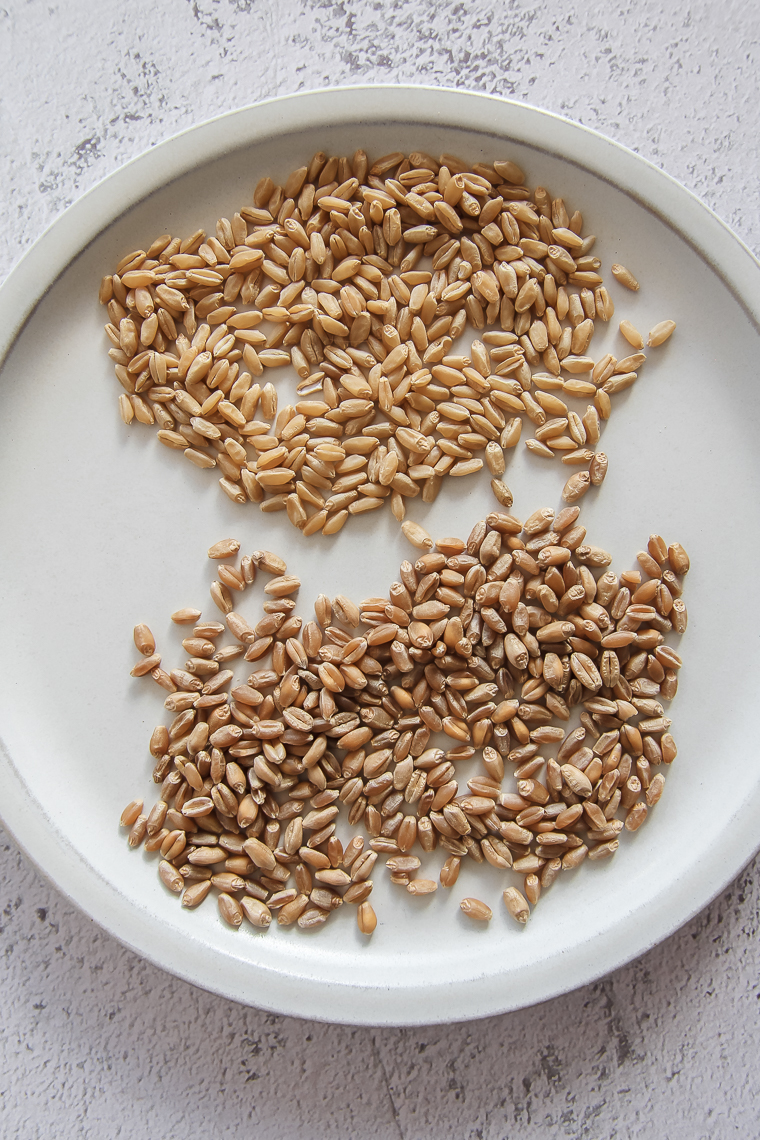



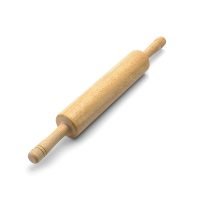
Good morning, I’m new to fmf and just wondering if you’ve made this recipe with fm soft white and if so how were your results? I really don’t want to sift but I have seen other people say there pie crust comes out a little gritty if they don’t sift.
Hi Debbie! Yes, the pie crust pictured here was made with fresh milled soft white. You can definitely detect the bran in the crust compared to a white flour crust, but I don’t think it’s gritty.
DOES WHOLE WHEAT WHITE FLOUR IN PIE CRUST STILL HAVE THAT CRUMBLED CRUNCH JUST LIKE ALL PURPOSE FLOUR ❓️👍👀
Hi there, whole wheat will not have the the same taste and texture as white flour because of the bran, but you can still get great results with it!